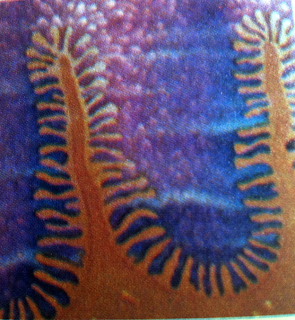Journey starts in the digestive organ
Some people feel more happy, confident, and relaxed when they are drinking. The alcohol seems to relieve their tensions and given them pleasure. These pleasant feelings may begin soon after alcohol enters the body.
1
But what is really happening in the body and the brain as the alcohol travels through? The alcohol in even one small drink is quickly absorbed, but it takes a long and complex journey before it is completely processed. The drink first enters the empty stomach (figure 1), and which minutes some of the alcohol is absorbed.
The rest passes into the small intestines, where it moves over a deeply folded absorbing surface covered by small projections
2
Called villi. Each villus is covered by even smaller microvilli (figure 2). Alcohol dissolved in intestinal fluids moves between these tiny projections and is absorbed into the cells and then into the blood capillaries beneath them (figure 3). From these capillaries the alcohol-laden blood flows into the larger blood vessels of the intestines.
Next it flows the networks of intestinal veins. The blood is carried
3
from the digestive organs to the portal vein, which runs to the liver. Inside the liver the portal vein divides repeatedly down to the microscopic level. Special capillaries, called sinusoids, carry blood to the liver cells.
Inside the sinusoids two kinds of bloodstreams join together one carrying oxygen absorbed from the lungs,
4
the other carrying alcohol and absorbed substances from the digestive organs (figure 4). Here some of the alcohol is oxidized and removed from the blood at a steady rate.
However, the liver cannot immediately remove all the alcohol passing through it. Therefore most of the alcohol escapes unchanged into the veins leading out of the liver to return later for oxidation. The alcohol-laden blood is transported from the liver to the heart. The heart then pumping it to other parts of the body, including the brain, where the blood-alcohol starts to take effected (figure 5).
5.
ALCOHOL AFFECTS THE BODY`S COMPUTER
The brain is a living computer made up of millions of nerve cells or neurons, complex networks (figure 6). The neuron is the basic
6.
Component of the brain`s data processing capacity. It is a single unit- a living cell- supported by other cells. It has a body, several hair-like processes called dendrites, and a longer central fibre called the axon.
A neuron communicates by responding to messages or signals. Incoming signals may make the neuron transmit its own signal along the axon towards other neurons. The neuron behaves like a living electric battery, maintaining a small voltage difference across its membrane, positive outside and negative inside.
When pulses of energy arrive, they may trigger a kind of short
7.
Circuit in the membrane. This brief discharge drives an electric pulse, the action potential, along the axon towards the synapse, this pulse being the contract with other neurons. There are two kinds of synapses: one contains excitatory chemicals, the other inhibitory chemicals. When an action potential reaches an excitatory
8.
Synapse, it releases molecules that create a current through the membrane and excite the neuron to fire (figure 7).
Both processes occur continually in the brain –inhibition and excitation. Excitatory signals can make the neuron fire vigorously (figure 8). Small doses of alcohol can make the neuron fire much less vigorously, and large doses can stop it completely. But if alcohol reduces the inhibiting signals, the neuron may start to fire more often than it should; this is called disinhibition.
ALCOHOL CAN CLOSE DOWN THE BRAIN
Alcohol can affect millions of nerve cells and change communication patterns through the brain.
9.
in the way disturbing specific brain functions. Alcohol can affect vision, distort hearing ,
10.
muddle speech , impair judgement (figure 9), dull the body`s senses, disturb motor skills, and reduce co-ordination. And deep inside the brain alcohol can affect the areas that control aggression, hunger and thirst, pleasure and pain, body temperature, and sexual activity.
The central core of the brain can be affected by alcohol, thus triggering the vomit centre and disturbing the centre of alertness, the reticular activating system. When no alcohol is present, the reticular system receives signals from brain and body and responds by sending out wake –up signals to keep the organism alert (figure 10). Alcohol may decrease the incoming signals and depress the reticular system itself. If the system is depressed too much, it may fail to maintain alertness. Stupor or coma may result. And the closes down.
MORE ALCOHOL, LESS JUDGEMENT
When alcohol enters the brain, it initially gives a pleasant glow. To try to maintain or increase that feeling, some people drink again and again. But the comfortable glow doesn`t last long. Through a complex journey alcohol circulates throughout the body and the brain, and if drunk in sufficient quantities, it can shut the brain down completely. This processes begins as alcohol is introduced into the body, and continues as drinking goes on. And the more person drinks, the less able he is to judge accurately what alcohol is really going to him.










No comments:
Post a Comment